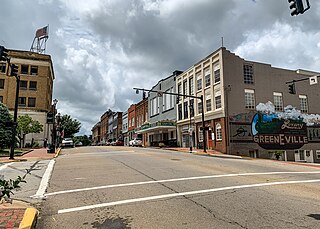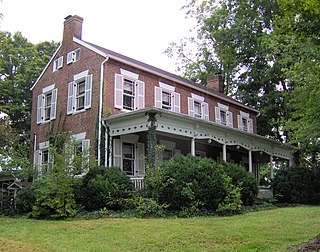
Greene County is a county located on the eastern border of the U.S. state of Tennessee. As of the 2020 census, the population was 70,152. Its county seat is Greeneville. Greene County comprises the Greeneville, TN Micropolitan Statistical Area.

Greeneville is a town in and the county seat of Greene County, Tennessee, United States. The population as of the 2020 census was 15,479. The town was named in honor of Revolutionary War hero Nathanael Greene, and it is the second oldest town in Tennessee. It is the only town with this spelling in the United States, although there are numerous U.S. towns named Greenville. The town was the capital of the short-lived State of Franklin in the 18th-century history of East Tennessee.

Jonesborough is a town in, and the county seat of, Washington County, Tennessee, in the Southeastern United States. Its population was 5,860 as of 2020. It is "Tennessee's oldest town".

David Crockett Birthplace State Park is a state park in Greene County, Tennessee, United States. Situated along the Nolichucky River, the park consists of 105 acres (0.42 km2) centered on the traditional birthplace of legendary Tennessee frontiersman, soldier, and politician Davy Crockett (1786-1836). The park includes a replica of Crockett's birth cabin, a museum, and a large campground.
Elmwood-on-the-Opequon is a farmstead near Kearneysville, West Virginia. The farm complex exemplifies the evolution of a prosperous West Virginia farmstead through the 19th and 20th centuries. The house has expanded around an original log cabin, gradually expanding with major expansions in the 20th century.

The Curtis—Shipley Farmstead is a historic home located at Ellicott City, Howard County, Maryland, United States. It is located on the first land grant in modern Howard County, then Anne Arundel County, to the English settler Adam Shipley in 1688 who settled properties in Maryland as early as 1675. The 500-acre estate was called "Adam the First".
James Owens Farm is a historic home and farm at Bristol, Anne Arundel County, Maryland. The home was built by successful tobacco farmer James Owens and is a large mid-19th century, two-story brick cross-gable late Greek Revival/Italianate dwelling. Outbuildings are all of frame construction and include an early 19th-century cornhouse, an early 19th-century tobacco barn, a mid-19th-century board-and-batten kitchen, carriage house, and smokehouse, and a late 19th-century chicken house.

The Tyson McCarter Place was a homestead located in the Great Smoky Mountains of Sevier County, in the U.S. state of Tennessee. Before the establishment of the Great Smoky Mountains National Park in the 1930s, the homestead belonged to mountain farmer Jacob Tyson McCarter (1878–1950), a descendant of some of the area's earliest European settlers. While McCarter's house is no longer standing, several outbuildings— including a barn, springhouse, corn crib, and smokehouse— have survived, and have been placed on the National Register of Historic Places.

Rose Glen was an antebellum plantation in Sevier County, in the U.S. state of Tennessee. At its height, Rose Glen was one of the largest and most lucrative farms in Sevier County and one of the most productive in East Tennessee. While the farm is no longer operational, the plantation house and several outbuildings— including a physician's office, loom house, and double-cantilever barn— have survived intact, and have been placed on the National Register of Historic Places.

Wheatlands is an antebellum plantation in Sevier County, in the U.S. state of Tennessee. The plantation's surviving structures— which include the plantation house, a storage shed, and smokehouse— have been placed on the National Register of Historic Places. The plantation house has been called "the best example of a Federal-style building remaining in Sevier County."

Maden Hall Farm, also called the Fermanagh-Ross Farm, is a historic farm near the U.S. city of Greeneville, Tennessee. Established in the 1820s, the farmstead consists of a farmhouse and six outbuildings situated on the remaining 17 acres (6.9 ha) of what was once a 300-acre (120 ha) antebellum farm. Maden Hall has been designated a century farm and has been placed on the National Register of Historic Places.

Chuckey is an unincorporated community in Greene County, Tennessee. It is located on the Nolichucky River, from which its name is derived. The community is the site of a post office and is assigned zip code 37641.

Mirador is a historic home located near Greenwood, Albemarle County, Virginia. It was built in 1842 for James M. Bowen (1793–1880), and is a two-story, brick structure on a raised basement in the Federal style. It has a deck-on-hip roof capped by a Chinese Chippendale railing. The front facade features a portico with paired Tuscan order columns. The house was renovated in the 1920s by noted New York architect William Adams Delano (1874–1960), who transformed the house into a Georgian Revival mansion.

The Jones Farm is a historic tobacco plantation house and farm located near Kenbridge, Lunenburg County, Virginia. It was built about 1846, and is a two-story, three-bay, frame I-house with a rear ell dated to about 1835. It is sheathed in original weatherboard and has a side gable roof. It features a front porch with Greek Revival style characteristics. Also on the property are the contributing smokehouse, ice house, granary, storage barn, tobacco storage facility, dairy stable, corncrib, two chicken coops, five tobacco barns, three tenant farmhouses, and the sites of a well house and tool shed.

Berry Hill is or was a historic home and farm complex located near Danville, Pittsylvania County, Virginia, United States. It was listed on the National Register of Historic Places in 1980. However, may be in the process of being delisted in connection with industrial development plans by Mega Site, the City of Danville and Pittsylvania County.

Valley View is a mid-19th-century Greek Revival residence and farm overlooking the South Branch Potomac River northwest of Romney, West Virginia. The house is atop a promontory where Depot Valley joins the South Branch Potomac River valley.

Clifton Place is an historic plantation mansion located southwest of the city of Columbia, Maury County, Tennessee on the Mt. Pleasant Pike. Master builder Nathan Vaught started construction in 1838, and the mansion and other buildings were completed in 1839, for Gideon Johnson Pillow (1806-1877) on land inherited from Gideon Pillow.

Dr. E. H. Ward Farm is a historic home and farm located near Bynum, Chatham County, North Carolina. The main house was built in sections during the mid-19th through early-20th century beginning about 1840. The earliest section is a 1+1⁄2-story, gable-roofed, two room log structure, that forms the rear of the main section. The main section was built about 1870, and is a one-story, gable-roofed frame structure with a simple gable-front porch. A one-story board-and-batten rear ell was added about 1900. Also on the property are the contributing office of Dr. Ward, carriage house and gear room, board-and-batten barn and log cribs, smokehouse and pen, and a small brick well house.
Hampton–Ellis Farm, also known as William Beanis Hampton Farm and Jonah Ellis Farm, is a historic home and tobacco farm located near Bahama, Durham County, North Carolina. The farmhouse was built about 1900, as a one-story, three-bay, center hall plan dwelling. It was enlarged about 1922, with the addition of a kitchen ell. The house features a one-story, hip-roofed front porch. Contributing outbuildings include the wood shed, cannery, smokehouse, feed house, tenant house, tenant smokehouse, tenant woodshed, pack house, ordering/stripping house, and four tobacco barns. With the exception of the ordering/stripping house and three of the tobacco barns, all the outbuildings were built about 1922.
Ivy Burne, also known as the John Murchison Hodges, Sr. House, is a historic home and farm complex and national historic district located near Linden, Harnett County, North Carolina. It encompasses eight contributing buildings and one contributing site on a rural farm complex.























